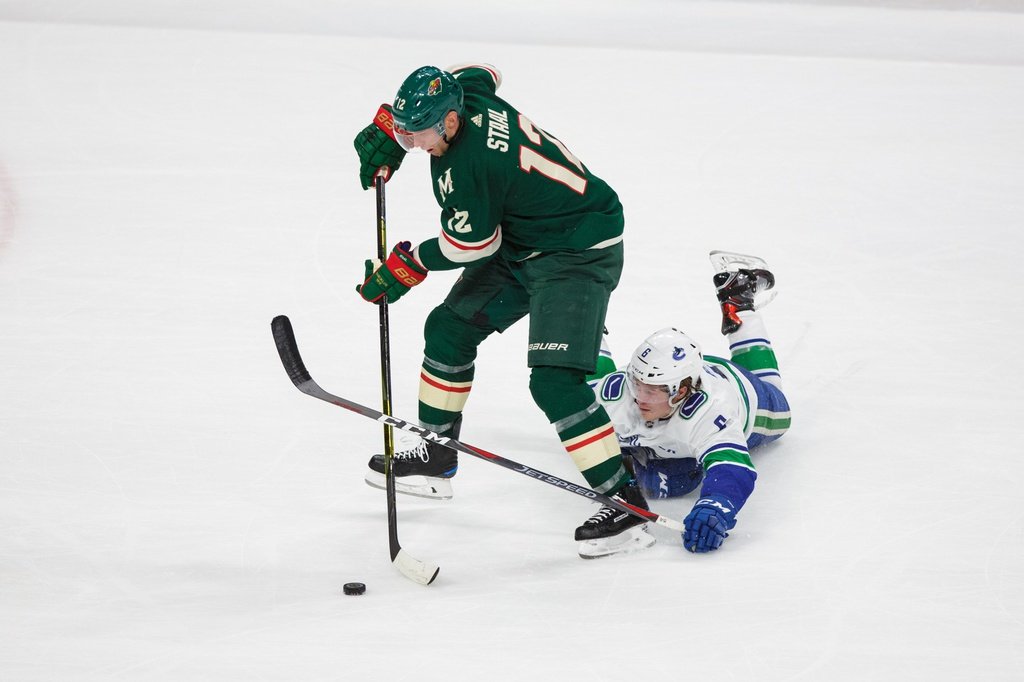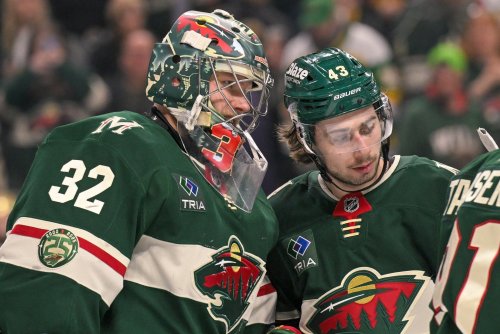
In the Stanley Cup Playoffs small moments become amplified. Nowhere is that more apparent than in moments of special teams. Whether it is the penalty kill or the power play, these moments can swing momentum for or against. Why? It’s because power plays and penalty kills comprise such a small portion of the game itself. The Minnesota Wild worked special teams almost to perfection in Game 1 against the Vancouver Canucks.
Minnesota capitalized twice with the man-advantage with goals by Kevin Fiala and Jared Spurgeon. Dean Evason had a game plan going into Game 1.
"We did talk about discipline,” Spurgeon explained. “Seems like every game we've been watching there have been a lot of power plays. Those can turn a game pretty quick. Fortunately for us, we were able to capitalize on our chances.”
"Our discipline was real good,” Evason said postgame. “Every coach is talking about discipline this time of year, obviously. In the playoffs you want to hold your composure. From the drop of the puck, we thought if we played hard but between the whistles and didn't get involved after the whistle. We were pleased with that area of our game."
When the final buzzer sounded, Minnesota had four power play opportunities to the Canucks’ one. The Wild played a strong, disciplined game to gain the upper hand in the special teams battle. A team can rely on its discipline to limit the chances for the opponent, while also putting the team in a better position to get the favorable call. That doesn’t mean the team is going to always take advantage of those chances.
Many have bore witness to Wild teams scuttling the timeliest of opportunities grabbing a lead, tying the game or putting a team away for good. This season, Minnesota has needed its power play early and often. They had 32 power plays up until the All-Star Break. That’s 32 in 52 games. But the Wild have been on a tear since.
The Wild scored 18 power play goals from February 1st to the time of COVID-19 hiatus. Fueled in part by Kevin Fiala going off for seven power play tallies while being featured on the top unit, but also Eric Staal and Spurgeon finding ways to get involved as well. Staal had four assists, and Spurgeon accumulated two goals and four power play assists.
It’s not a surprise that those three players factored into the scoring on the power play against the Canucks in Game 1. Taking a look back at each goal and we can see what the Wild are attempting to accomplish that’s allowed them to have so much success.
Let’s first start with the Spurgeon power play goal from the second period of Game 1.
Spurgeon PPG
The Canucks were passive at their own blue line, allowing for an easy entry by the Wild. Zach Parise is near the far wall carrying the puck in for a dump-in. Spurgeon is idle on the blue line. Once the puck crosses the line, he circled around into the spot vacated by Parise. Notice Staal on the near wall and not pressuring once he notices both Ryan Suter, Fiala, and Parise are crashing toward the puck with Jacob Markstrom leaving the net to play the puck.
Staal stayed back because he noticed that Suter drifted deep. Staal was protecting against an odd-man rush the if Markstrom made a good play with the puck.
Indeed, Markstrom does go high off the glass to that side, perhaps not seeing Spurgeon filling in for Parise as the Wild crossed the line. Spurgeon just keeps the puck onside. Tyler Motte of the Canucks is late to pressure Spurgeon and the Wild defenseman has time to make a smart pass to the open side for Staal.
Jay Beagle barely realizes that Staal is there this entire time. Rather than pressure, he tries to keep Staal near the wall. Staal moves up the half-wall to find the gap in the box the Canucks are positioned in.
Staal recognizes that Motte has just abandoned Spurgeon and has a good passing lane. He just needs to buy some time for Spurgeon to recognize it as well and pinch in from the blue line. Finally, Staal draws Beagle in and gets Christoph Tanev to commit. That’s when he sends a saucer pass through the wide open passing lane to Spurgeon for the power play goal.
Staal became the primary distributor on the power play, and he delivered a perfect pass for Spurgeon to finish off. That Staal is the passer on the man advantage is a slight wrinkle in the Evason-run power play. He’s normally set up down low or in the slot to be the size lower in the zone. He’s now working from the half-wall with frequency. That change is apparent in the Dumba goal against the Avalanche.
Fiala PPG
The Wild caught a bit of luck with Markstrom flubbing the save with the glove. But that doesn’t mean there isn’t something to take away from the play. This one comes right off a faceoff in the offensive zone. Take note of the faceoff alignment. A traditional faceoff alignment would have three forwards in the faceoff dot and two defensemen back along the blue line.
In this front by the Wild, it is Suter and Fiala back with Fiala to the back and to the right of the dot. Jared Spurgeon is up near the far wall in the faceoff circle.
The play begins with a clean faceoff win by Staal. Spurgeon jumps on the loose puck and sends a feed directly to Fiala who’s winding up for a one-timer. The play is successful as Fiala gets all of it and gets the puck on net. That Fiala got the puck quickly, starting with the clean faceoff win, and a perfect setup pass from Spurgeon, Fiala’s shot, even from just inside the blue line was too quick for Markstrom to get into position. It set the table for the rest of the game as the Wild could roll all four lines with the early lead.
Dumba Exhibition PPG
The power play goal scored by Matt Dumba in the exhibition game against the Colorado Avalanche is included here to show a pattern. However, the Wild are on a 4-on-3 man advantage. Minnesota, again, is running the power play through Fiala and Staal. Staal is down low in the right offensive circle.
With more space on the ice in the 4-on-3, the Wild power play starts squeezing in close. Dumba circles around the top of the zone to find some real estate in the left offensive faceoff circle. He makes a call for the puck and Staal makes another saucer pass right on the money for another one-time slap shot that beats Avalanche goalie Philipp Grubauer.
Again, the trend here is that Staal is the one dishing the puck. Additionally, in this power play set up, he had Fiala on the point, and, where he eventually went, a one-timer option in Dumba.
These wrinkles on the power play will help the Wild to continue the scorching hot power play trend that started after the All-Star break. It’s allowed Minnesota to feature high percentage shooters as passing options while Eric Staal finds ways to distribute and reap the benefits. As long as the Wild can stick to the Evason game plan on discipline, Minnesota can make this a quick series. Even where special teams weren’t some important thing, but the only thing in a Stanley Cup Playoff series where small moments are amplified.
Think you could write a story like this? Hockey Wilderness wants you to develop your voice, find an audience, and we'll pay you to do it. Just fill out this form.








Recommended Comments
There are no comments to display.
Join the conversation
You can post now and register later. If you have an account, sign in now to post with your account.
Note: Your post will require moderator approval before it will be visible.